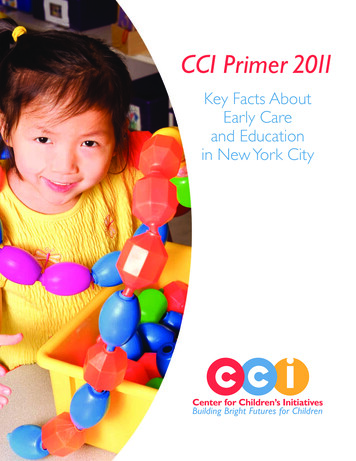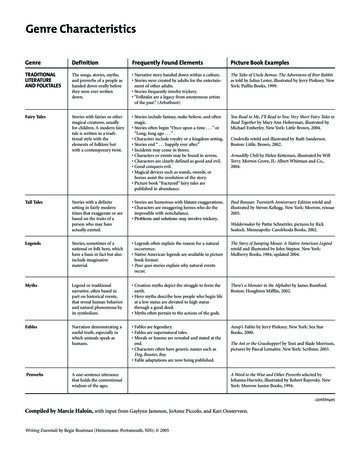
Transcription
CCI Primer 2011Key Facts AboutEarly Careand Educationin New York City
About CCICCI champions the right of all children to start life with the best possiblefoundation of care, health and learning. CCI draws on our experience,expertise, and interactions with families, early childhood professionals andpolicymakers to shape our vision to expand and improve early learningopportunities, in order to build bright futures for all children.CCI serves as a trusted resource for working families, offering consultationand referral to help parents identify and select appropriate, affordable,quality child care options.Our services reach all types of service providers across the city and addressthe need for professional development and strategic expansion of early careand learning services throughout the city. Providing training, mentoring andcoaching to early care and learning professionals to enhance quality. CCIshares best practices and provides educational opportunities to those caringfor and educating our children.CCI serves as a catalyst for strengthening public policies that support qualityearly care and education. Our recommendations are informed by both ourday-to-day interaction with families and service providers as well as thelatest research which shows that quality care in a child’s earliest years canpay dividends over a lifetime.CCI is supported by grants from private foundations, corporations andgovernment agencies, fee-for-service contracts and individual donors.
CCI Primer 2011Key Facts AboutEarly Care and Educationin New York CityNancy Kolben, Executive DirectorBetty Holcomb, Policy DirectorJudehia Dixon, Policy Intern
Table of ContentsDemographics: New York City’s Children and Families .6 New York City Children 14 and Younger, 2000-2010 .7 New York City Children Under 5, by Borough, 2010 .7 New York City Children Under 5 Below the Federal Poverty Level, by Borough, 2010 .8Enrollment: Publicly-Supported Early Care and Education .9Overall Enrollment Children Under 6 Enrolled in Regulated Early Care and Education, 2010-2011 .11 All Children Under 12 Receiving Child Care Assistance, by Age, 2007-2011.11 Children Receiving Child Care Assistance in Regulated Settings, by Age, 2011 .12 All Children Receiving Child Care Assistance, by Setting, 2003-2011 .13 Children Receiving Child Care Assistance, in Child Care Centers, by Age, 2011 .13 All Children Enrolled, Regulated and License-Exempt Care, 2003-2011.14 Children Enrolled in Subsidized Care, Contracts and Vouchers, 2007-2011 .15Enrollment: Children Under 3 Children Under 3 Enrolled in Child Care (ACS and TANF) and Early Head Start, 2007-2011.16 Children Under 3 Receiving Child Care Assistance, by Setting, 2011 .16Enrollment: Children 3-5 Children 3-5 Receiving Child Care Assistance, 2007-2011 .17 Children 3-5 Receiving Child Care Assistance, by Setting, 2011.17Enrollment: Head Start Programs Children 3-5 Enrolled in Head Start Programs, 2010 .18 Children 3-5 Enrolled in ACS Head Start, by Length of Day, 2010 .18 Children 3-5 Enrolled in ACS Head Start, by Ethnicity, 2010 .18Enrollment: Universal Prekindergarten Children Enrolled in Universal Prekindergarten, 2002-2011 .19 Children Enrolled in Universal Prekindergarten, by Setting, 2007-2011 .19 Children Enrolled in Universal Prekindergarten, by Borough and Setting, 2011 .19 Children Enrolled in Universal Prekindergarten, by Borough and Length of Day, 2011 .20Enrollment: School-Age Children 6-12 Receiving Child Care Assistance, 2003-2011 .21 Children 6-12 Receiving Child Care Assistance, by Setting, 2011 .21Public Investment in Early Care and Education .22 Public Funding for Early Care and Learning, Fiscal Year 2011 .23 ACS Child Care Budget by Funding Source, 2000-2011 .24 ACS and TANF Child Care Funding, 2003-2011.24 ACS and TANF Average Expenditure Per Child, 2000-2010 .24 Universal Prekindergarten, Budgeted Expenses, 2005-2011.25 Universal Prekindergarten State Funding, City Use of Funds, by Setting, 2007-2010.25 Universal Prekindergarten State Aid, Per-Pupil Allocations, 2003-2012.254CCI PRIMER 2011 Key Facts about Early Care and Education in New York City
Table of ContentsCapacity for Early Care and Education .26 Number of Providers Licensed/Registered, 2011.27 Child Care Centers, Licensed Capacity, 2011.27 Regulated Capacity for Year-Round, Full-Day Services, by Setting, 2011 .27 Trend in Regulated Capacity for Year-Round, Full-Day Services, by Setting, 2007-2011 .28 Capacity to Serve Children Under 3 in Regulated Settings, 2011 .28 Need for Full-Day, Out-of-Home Care for Children Under 3, 2011 .29 Capacity to Serve Children Under 3 in Regulated Settings, by Borough, 2011.29 Capacity Versus Need, Regulated Care for Children Under 3, 2011 .29Access and Affordability .30 Maximum Eligibility for Child Care Assistance, by Family Size, 2011 .31 Co-Payment, Families Eligible for Child Care Subsidies (Family of Three), 2011 .31 ACS and TANF Children Enrolled by Poverty Level, 2011 .31 Children on Public Assistance, by Age and Borough, 2011.32 TANF Children Served by Reason for Care, 2011.32 ACS-Head Start Enrollment, by Eligibility, 2010 .32 State’s Established Market Rate, Child Care, 2009-2011 .33 Expectation of What Parents Should Contribute Early Childhood Education v. College(Family of Four, with Two Children), 2011 .33 Private Tuition Data .34Quality Indicators .35 Number of NAEYC Accredited Child Care Programs, by Borough, 2011 .36 Pay Difference,Teachers in ACS-Funded Centers and Public School .36Specialized Services: Early Intervention and Home Visiting .37 Referrals and Enrollment in Early Intervention Services, 2009-2011.38 Families Enrolled in Home Visiting Programs, 2010-2011 .38 Early Intervention Services, by Funding Source, Projected 2011-2012 .38 Public Funding for Home Visiting, Fiscal Year 2010-2011 .38Glossary.39Types of Child Care and What the Law Requires .42CCI PRIMER 2011 Key Facts about Early Care and Education in New York City5
Demographics:New York City’sChildren and FamiliesNew York City now has nearly 518,000 childrenunder five, about 6% of the population. (Chart 1) Brooklyn has the most children under 5:177,000 in 2010 –a third of the city’s totalpopulation of children under 5. (Chart 2)Children in PovertyThirty percent of the city’s children under 5 livein poverty. For a family of three, that means livingon 18,530 a year.The distribution of young children living inpoverty varies dramatically from borough toborough.Young children in the Bronx arehardest hit. (Charts 3 and 3A) 44% of Bronx children under 5 live in poverty. That compares to 17% in Manhattan and20% in Staten Island.6CCI PRIMER 2011 Key Facts about Early Care and Education in New York City
DemographicsChart 1New York City Children 14 and Younger, 2000-2010Age Group20002010ChangePercent 2,8091,459,037-173,772-11%Source: U.S. Census Bureau,American Fact Finder, Demographic Profile, New York CityDepartment of City Planning, 2000, 2010.Chart 2New York City Children Under 5, by Borough, 2010BoroughTotal PopulationAll AgesUnder5 YearsPercent ofChildren Under 426%468,73028,3395%8,175,133517,724100%Staten IslandTotalSource: U.S. Census Bureau,American Fact Finder, Demographic Profile, New York City Department of City Planning, 2010.Chart 2ANew York City Children Under 5, by Borough, 2010Staten Island15%Bronx20%Queens26% Bronx Brooklyn Manhattan QueensManhattan15%Brooklyn34% Staten IslandCCI PRIMER 2011 Key Facts about Early Care and Education in New York City7
DemographicsChart 3New York City Children Under 5 Below the Federal Poverty Level, by Borough, 2010BoroughTotal PopulationUnder 5Total Populationin Poverty Under 5Percent of ChildrenUnder 5 UnderFederal Poverty en Island28,3395,63020%517,724152,93030%TotalSource: U.S. Census Bureau,American Fact Finder2,American Community Survey, Poverty Estimates, 2010.Note: Release date for this information was September 2011.Chart 3APercent of Children Under 5 Below Federal Poverty Level, by Borough, 2010BronxBrooklynManhattanQueensStaten IslandTotal All Boroughs01020304050Percentage of all children under the age of 58CCI PRIMER 2011 Key Facts about Early Care and Education in New York City
Enrollment: PubliclySupported EarlyCare and EducationYoung children attend programs in a variety of settings, including Head Start programs, early childhoodcenters, public, private and parochial schools and other community settings. Universal Prekindergarten (UPK)is offered in both public schools and community-based programs. Overall, more than 207,000 childrenunder 6 were enrolled in regulated care that was partially or fully supported by public funds. (Chart 4)Subsidized Child CareThe Administration for Children’s Services (ACS) manages publicly-funded child care in New York City.Families receiving Temporary Assistance to Needy Families (TANF) are guaranteed child care assistance,if they are working or in training. Other low-income families have no such guarantee, even if they meeteligibility guidelines.† A
CCI PRIMER 2011 Key Facts about Early Care and Education in NewYork City 7 Chart 2 NewYork City Children Under5,byBorough,2010 Source:U.S.Census Bureau,American Fact Finder,Demographic Profile,NewYork City Department of City Planning,2010. Chart 1 NewYork City Children 14andYounger,2000-2010











